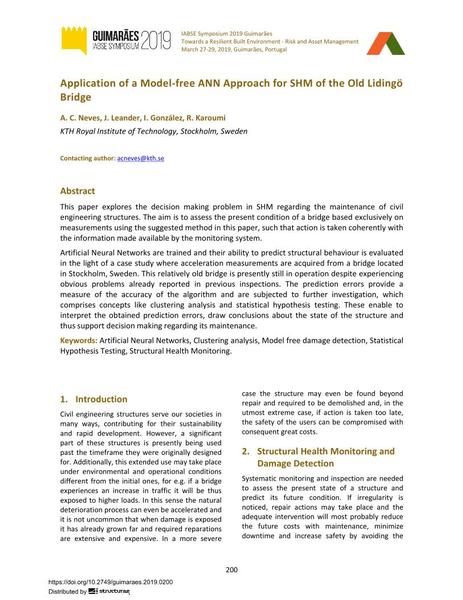Application of a Model-free ANN Approach for SHM of the Old Lidingö Bridge

|
|
|||||||||||
Bibliographic Details
| Author(s): |
Ana C. Neves
(KTH Royal Institute of Technology, Stockholm, Sweden)
John Leander (KTH Royal Institute of Technology, Stockholm, Sweden) Ignacio Gonzalez (KTH Royal Institute of Technology, Stockholm, Sweden) Raid Karoumi (KTH Royal Institute of Technology, Stockholm, Sweden) |
||||
|---|---|---|---|---|---|
| Medium: | conference paper | ||||
| Language(s): | English | ||||
| Conference: | IABSE Symposium: Towards a Resilient Built Environment Risk and Asset Management, Guimarães, Portugal, 27-29 March 2019 | ||||
| Published in: | IABSE Symposium Guimarães 2019 | ||||
|
|||||
| Page(s): | 200-211 | ||||
| Total no. of pages: | 12 | ||||
| DOI: | 10.2749/guimaraes.2019.0200 | ||||
| Abstract: |
This paper explores the decision making problem in SHM regarding the maintenance of civil engineering structures. The aim is to assess the present condition of a bridge based exclusively on measurements using the suggested method in this paper, such that action is taken coherently with the information made available by the monitoring system. Artificial Neural Networks are trained and their ability to predict structural behaviour is evaluated in the light of a case study where acceleration measurements are acquired from a bridge located in Stockholm, Sweden. This relatively old bridge is presently still in operation despite experiencing obvious problems already reported in previous inspections. The prediction errors provide a measure of the accuracy of the algorithm and are subjected to further investigation, which comprises concepts like clustering analysis and statistical hypothesis testing. These enable to interpret the obtained prediction errors, draw conclusions about the state of the structure and thus support decision making regarding its maintenance. |
||||
| Keywords: |
structural health monitoring clustering analysis Artificial Neural Networks Model free damage detection Statistical Hypothesis Testing
|
||||
